
Treating Burns Page Selection Menu: 1 2 3 4 5 6 7 8 9 10 Next>>
Treating Burns During the Golden Age of Piracy, Page 6
Burn Treatment
"The Officer then approached [captured pirate] Roger Ball, who was seated in a private Corner,
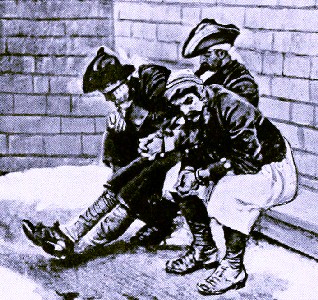
Artist: Howard Pyle
with a Look as sullen as Winter, and asked him, how he came blown up in that frightful Manner. — Why, says he, John Morris fired a Pistol into the Powder, and if he had not done it, I would, (bearing his Pain without the least Complaint.) The Officer gave him to understand he was Surgeon, and if he desired it, he would dress him, but he swore it should not be done, and that if any Thing was applied to him, he would tear it off. Nevertheless the Surgeon had good Nature enough to dress him, tho' with much trouble. At Night he was in a kind of Delirium, and raved on the Bravery of Roberts, saying, he should shortly be released, as soon as they should meet him, which procured him a lashing down upon the Forecastle, which he resisting with all his Force, caused him to be used with the more Violence, so that he was tied down with so much Severity, that his Flesh being sore and tender with the blowing up, he died next Day of a Mortification." (Captain Charles Johnson, The General History of the Pyrates, 3rd Edition, p. 269)
While Roger Ball may not have wanted treatment for his burns, most men would have been grateful for any relief that a surgeon could supply for them. We have already seen the humoral treatments, which we today know would have had no real effect on the burn, but which were still used by the medical community because they were espoused by the revered 'ancient' physicians like Hippocrates and Galen. Fortunately,
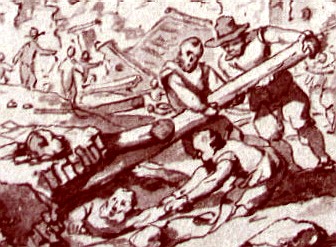
Artist: Gerbrand van den Eeckhout
After the Gunpowder Explosion (1654)
other treatments were a bit more effective with some being similar in many ways with the way burns are treated today.
Period attitudes towards burn treatments from the period are interesting. Richard Wiseman explained that "however people, cry, It’s nothing to cure a Burn"1. The lesser importance of burns can be recognized by who tended them during battles when wound treatment was usually prioritized. Surgeon Vice Admiral Sir James Watt explains that the surgeon, "overwhelmed by casualties, could do no more than give his attention to the arrest of haemorrhage and amputations, leaving his mate [or assistant] to treat the numerous burns with cooling lotions or oily dressings."2
John Woodall advises his surgeon trainees that "Burning by Gun-powder often-times is incident in Arme to Soldiors and others, which wanteth no grievous accidents; therefore be ready at all times with remedies fit and effectuall to asswage them."3 This hints that the surgeon will be otherwise occupied and it was left to the mates and assistants to care for burn patients.
Period surgeons recognized that burns resulting from different sources could basically be treated like like each other.
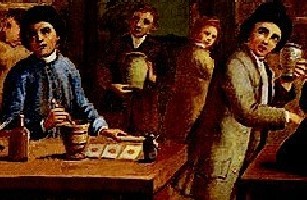
Medicine Preparation, Italian Apothecary (18th century)
Wiseman explained, "Whether they are burnt by Gun-powder or any other way, their Cure is much alike, they only differing secundum magis & minus. [according to how bad they are]."4 William Fabry explains that even though burns "be made of divers matters, as with mettals and liquors, as we have afore declared, yet that little or nothing profiteth to the cure; for even as Combustions made with red hot Iron is like unto Combustions made with Gold or Silver being hot, so also Combustions whether they be made with hot Oyle, wax, pitch, &c."5 He further explains that different types of burn did not "require a particular Method in curing"6.
As Watt explained,
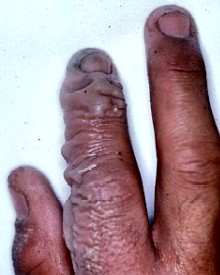
Photo: Dr. Charles Eaton
Burn Blistering on Index Finger
the most obvious treatments were topical ointments and dressings. During Horatio Nelson's era in the latter half of the 18th century, Tony Harrison noted that "Treatments for [burns] were a variety of applications to the affected area including linseed oil, lime water, cerusa, olive oil and compresses of vinegar."7 Many of these treatments had a legacy that dated back before the golden age of piracy as we shall see.
In addition to medicines, there were several other components to burn treatment. Dressings were an obvious part of treating a burn, both to keep the medicine in place and to protect the wound. For more severe burns, debridement - removal of the burned and damaged skin on the surface of the wound - was performed in a limited way. Closely related to this was treatment of blisters which often accompany the more serious burns. Since burn treatment usually resulted in scarring, golden age of piracy period surgeons addressed this topic as well, focusing particularly on how to minimize scars. This was especially true for burns of the face. Each of these facets of burn treatment will be examined in the following sections
1 Richard Wiseman, Of Wounds, Severall Chirurgicall Treatises, p. 440; 2 Vice-Admiral Sir James Watt, "The burns of seafarers under oars, sail and steam", Injury: the British Journal of Accident Surgery, Vol. 72; 3 John Woodall, the surgions mate, p. 145; 4 Wiseman, ibid. 5 Guliielm. Fabritius Hildanus aka William Fabry, His Experiments in Chyrurgerie, p. 3; 6 Hildanus, ibid.; 7 Tony Harrison, "Nelson and his Navy – Surgery in the Royal Navy," The Historical Maritime Society
Burn Treatment - Medicines
Most of the medicinal treatments used on burns were topical. Although medicine had been developing for millennia, it was still in its infancy at this time. Every application was homeopathic in nature and each surgical author seemed to have a different idea about what worked best.
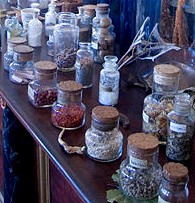
An Apothecary's Shelf
Medicines had several different functions, just as they do today. The first applications were used to seal the wound and help alleviate the pain. William Fabry proudly identifies an ointment that he believed to be something of a burn cure all because it "easeth paine, softneth the skin, and resolveth [dissipates] the Humours flowing to the [burned] part"1. Sea-surgeon John Woodall likewise advises that pain-killers (anodyne medicines) should be given "to make it more easie for suppuration"2. Suppuration is the formation of pus, which was thought to be a sign of the bad humors leaving the wound during this era in surgery. Anodynes would certainly help make the misunderstood encouragement of infection more tolerable for the patient! Woodall suggests a salve and cold cream for the patient's relief, among other things.
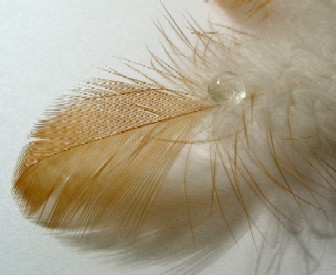
Photo: Roger McLassu
- A Burn Medicine Applicator
Because of the sensitive nature of burned skin, several surgeons seem to agree on the method of application of medicines to a singed area. Sea-surgeon John Moyle, clearly concerned about the amount of pain the patient was in, advised that the "best way to annoint Burns is to do it with a Feather dipt in the Medicine, and lightly Stroked on the parts effected."3
In his book of home remedies, surgeon Stephen Bradwell advises preparing a camphor-based ointment "in which dipping a feather, [the surgeon should] annoint the part burned, and lay a fine soft linnen cloth upon it. Repeat the annoynting often."4 Even the usually staid and serious Richard Wiseman agrees that the use of a feather makes the best ointment applicator.5
If
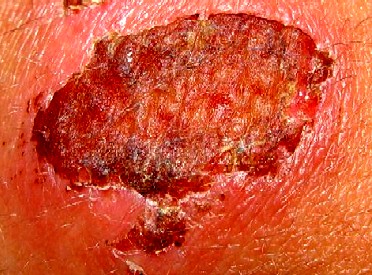
A Large Escar on Burnt Skin
there was an escar or section of hard, scabbed skin, it was to be softened. Surgeon Richard Wiseman says that when the patient's skin is "burnt to a Crust or Eschar, you must hasten its fall with Emollients"6. For burns involving a large loss of skin, medicines were applied that would allow the rebuilding of lost skin and finally to heal the wound over. Wiseman tells his readers to apply medicine which would "digest [rebuild skin], incarne [encourage the formation of tissue inside the wound], and cicatrize [heal the wound over with a scar.]"7
Wiseman also explains that for large burns "there are required [a] variety of Intentions at one and the same times. Some require Anodynes [pain killers] others Detergents [cleansing medicines] and Digestion, others Desiccants [medicines that dry a wound]."8 So the general types of medicines required depended on the severity and characteristics of the wound.
Having said all hat, we will focus less on the classifications
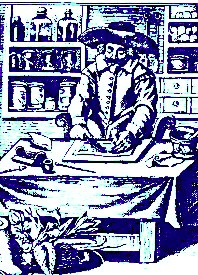
An Apothecary at Work, From The
Workes
of that Famous Chirurgeon
Ambrose Parey, p. 418 (1649 )
of the medicines and more upon the actual preparations In the following pages. Some surgical authors prefer to give recipes for complex concoctions, perhaps feeling that the more ingredients they put into their creations, the more likely they were to include something that would prove effective. These prescriptions are typically in abbreviated Latin and are often time-consuming and frustrating to decode and often make for challenging reading.
. By way of example, when treating second degree burns, William Fabry lists three different prescriptions, one of which is shown below.
"Rx. Unguent Basilicon.[basilicon ointment – black pitch, yellow resin & yellow wax] {1 ounce} Ol. Rosar.[oil of roses] & hillier. Albor. [egg white] Ana. {1/2 ounce, mixed in equal quantities} Vitel. Ovor. [egg yolk] nam. {2 ounces} misce. {mixed}"9
Reading through several of these is challenging at best and not very helpful since everything has to be explained in notes added to the prescription. So the next two pages will examine several specific ingredients commonly used by the various period authors. Before we do that, however, let's have a look at one last method for classifying medicines.
1 Guliielm. Fabritius Hildanus aka William Fabry, His Experiments in Chyrurgerie, p. 27; 2 John Woodall, the surgions mate, p. 145; 3 John Moyle, Memoirs: Of many Extraordinary Cures, p. 116; 4 Stephen Bradwell, Helps For Suddain Accidents Endangering Life, p.121; 5 Richard Wiseman, Of Wounds, Severall Chirurgicall Treatises, p. 441; 6 Wiseman, ibid.; 7 Wiseman, ibid.; 8 Wiseman, p. 442; 9 Hildanus, p. 27
Hot and Cold Humoral Medicines
The concept of humors lurked behind some of the classes into which medicines were divided. Ancient physicians wrote that medicines had different humoral properties and this was used as a guide in deciding which of medicines should be used on which wounds. Like the four elements of the earth and the four humors of the body, there were four characteristics of plants, foods, and medicines: hot, cold, moist/wet and dry. Hot and cold were the two traits of most concern when treating burns. Different surgeons espoused one or the other and sometimes both.
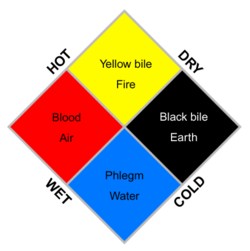
The Four Humors and Their Properties
Military surgeon Richard Wiseman explains that hot medicines could assuage "the fiery Heat and Pain by Rarefaction [reduction in density]. Which in the first place may be done by the holding a burning hot Iron or Fire to the Part: So whilst the Fire calls for the Fire it made, it becomes its Alexiterium [remedy]."1
William Fabry writes that "hot Medicines doe quickly coole (yet by evacuation) by discussing [dispersing] and extracting corrupt humours, as Galen witnesseth."2 He further explains that "heat (as Hipocrates witnesseth) softenth the skin, extenuateth, easeth paine, mitigateth Convulsions, and bringeth Ulcers to suppuration [the sign that the 'bad' humors were escaping]: So such kind of Medicines [hot] are applyed to those parts which are molested with [bad] blood, (but they must be those which doe moderately heat) to make thin the humours, and to dilate the passages and pores"3. Essentially his argument is that hot medicines were preferable because they purged bad humors from the wound, allowing the body to cool, which he elsewhere refers to as 'abating'.4
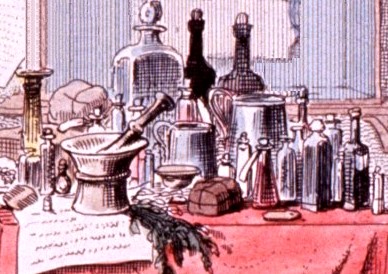
Apothecary Ingredients
Wiseman also suggests the use of cooling medicines, also called refrigerants. He identifies a whole list of them for use in burns in his book:
...aq. solani [bittersweet water – made from Solanum dulcamara], plantag[plantago/plantain water], hyoscyam.[black henbane water] lac ebutyratum; and all the cooling Juices and Unguents, as unguent. Album [white salve – made from oil of roses, white lead and white wax], nutritum [ointment made from oil and litharge], populneum [a black ointment – made from black poplar, lard and various herbs such as black henbane, black poppies and nightshade], rosat. [rose ointment] - &c."5
Wiseman explains that when applied to burns such cooling medicines "must be used warm, until the Heat and Pain cease, or the fire be taken out [of the wound], (as the common expression is;) else they will rather cause Pain."6 Sea-surgeon John Moyle also advised the use of such medicines7 and in one of his case studies, we find Ambroise Paré on his way "to the next

Military Surgeon and Author Richard Wiseman
Apothecaries to fetch refrigerating medicines commonly used"8 in burns.
The theory here is that since a burn is hot, the opposite type of medicine should be used to draw the heat out. This was taken from Hippocrates 22nd aphorism which states that "Contraries are the remedies of Contraries."9 Fabry (who doesn't agree as we shall see) explains this theory, noting that since "Combustions [burning] is a hot accident, wee ought to cure it with his contrary, which is with cold things, which may extinguish the hot & burning humours left by the fire"10.
Admitting that the opposites cure theory is valid in general, Fabry still believes that cold medicines are improper for burns. He explains that "cold things are plainly adversaries to Combustions, and do cause divers and naughty accidents, for the skin being contracted and hardned by fire, by the much use of cold Medicines [the skin] is hardned, and paine is increased; hereby humours do gather together which are not onely retained under the hard skin, but by the use of cold Medicines is forced downwards... [resulting in] inflammation, impostimation [creation of abscesses], and divers times Gangrene, for the humour included, because it wanteth breathing, it presently putrifieth, as Galen witnesseth"11. Because he believes hot medicines will disperse the bad humors collecting at the wound-site, he feels they serve the burn patient better than 'cold' ones.
Wiseman actually separates the use of hot and cold medicines in his book, explaining that "Refrigerants [are used] to bath[e] or anoint the Part, until the Heat be off, and the Eschar [dead surface tissue] separated, and then to digest [grow new skin] and cicatrize [heal over]"12. On the other hand, he suggests that the surgeon can heal a burn using "calefactive [heating] Medicaments to relax the Skin, and resolve [dissolve] and dissipate it, which by accident will asswage the heat and Burning."13
1 Richard Wiseman, Of Wounds, Severall Chirurgicall Treatises, p. 440;2 Guliielm. Fabritius Hildanus aka William Fabry, His Experiments in Chyrurgerie, p. 14; 3 Hildanus, ibid.; 4 Hildanus, p. 12; 5 Wiseman, p. 441; 6 Wiseman, ibid.; 7 John Moyle, The Sea Chirurgeon, p. 96-8; 8 Ambroise Paré, The Apologie and Treatise of Ambroise Paré, p. 140; 9 C.J. Sprengell, The Aphorisms of Hippocrates and the Sentences of Celsus, p. 27; 10 Hildanus, p. 12; 11 Hildanus, p. 14; 12 Wiseman, p. 440; 13 Wiseman, ibid.

